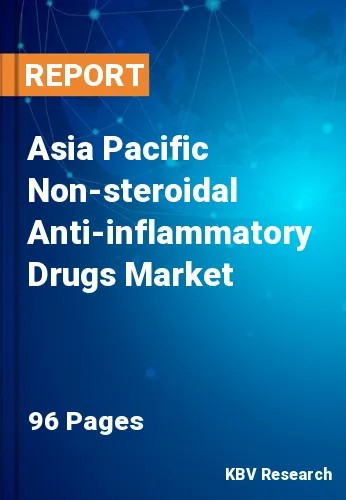
The Asia Pacific Non-steroidal Anti-inflammatory Drugs Market would witness market growth of 6.2 % CAGR during the forecast period (2022-2028).
The most often prescribed medications in the world are non-steroidal anti-inflammatory medicines (NSAIDs). They are used to treat pain, fever, and inflammatory symptoms. It is comprehended that the medications known as NSAIDs are also those who reversibly inhibit cyclooxygenase (COX), and by extension, the synthesis of prostaglandins, despite the fact that the term is not very precise and could refer to a wide range of other medications used to treat chronic rheumatic disorders. As prostaglandins are ubiquitous aracoids that have a wide range of effects on different body parts, blocking their synthesis may have an impact on numerous system organs, which explains the variety of NSAID indications and side effects.
There are various different chemical families of NSAIDs, but their pharmacokinetic profile, potency, as measured by the IC50 or IC80 for the two isoforms of COX, and the proportion of their affinity for the COX isoforms all are potentially major traits. The medications' final effects and tolerance profile will be impacted by this equilibrium. In a nutshell, suppression of the COX1 isoform affects ductus arteriosus closure, gastrointestinal toxicity, uterine contractions in late pregnancy, and platelet synthesis of thromboxane. Although COX2 inhibition is anti-inflammatory, it also has an impact on renal and epithelial function. Certain NSAIDs which are more specific or favour the COX2 isoform were dubbed "Coxibs" for marketing purposes.
They don't differ in any way from what are known as traditional or non-selective NSAIDs, some of which might be more selective of COX2 than some so-called "Coxibs," in terms of their effects. Less gastrotoxicity is the outcome of enhanced COX2 selectivity, but it may also mean poorer pain relief and greater cardiovascular risk. Potentiality must, of course, be used to balance this. The COX-2 favouring medication diclofenac that is no longer selective at the levels employed, is by far the most effective NSAID at inhibiting COX.
Turmeric, a member of the ginger family and a source of curcumin, is a spice. It is used to relieve digestive issues, promote wound healing, and decrease inflammation in both Chinese & Ayurvedic medicine. Three times a day, 400–600 mg of turmeric powder is the recommended dosage. There aren't many side effects, but they can irritate the stomach, and in rare cases, consuming a high dose could result in gastric ulcers. Caution is advised if patients are taking large doses of NSAIDs or anticoagulant drugs. A method employed in conventional Chinese medicine is acupuncture. Acupuncture works by stimulating certain places on the body with tiny needles in order to treat diseases like pain or other issues.
The China market dominated the Asia Pacific Non-steroidal Anti-inflammatory Drugs Market by Country in 2021, and would continue to be a dominant market till 2028; thereby, achieving a market value of $2,268.5 Million by 2028. The Japan market is estimated to grow a CAGR of 5.5% during (2022 - 2028). Additionally, The India market would experience a CAGR of 6.9% during (2022 - 2028).
Based on Route of Administration, the market is segmented into Oral, Topical and Others. Based on Distribution Channel, the market is segmented into Retail Pharmacy, Hospital Pharmacy and Online Pharmacy. Based on Route of Disease Indication, the market is segmented into Arthritis, Migraine, Ophthalmic Diseases and Others. Based on countries, the market is segmented into China, Japan, India, South Korea, Singapore, Malaysia, and Rest of Asia Pacific.
Free Valuable Insights: The Worldwide Non-steroidal Anti-inflammatory Drugs Market is Projected to reach USD 25.5 Billion by 2028, at a CAGR of 5.7%
The market research report covers the analysis of key stake holders of the market. Key companies profiled in the report include Dr. Reddy’s Laboratories Ltd., Pfizer, Inc., GlaxoSmithKline PLC, Bayer AG, Teva Pharmaceuticals Industries Ltd., Eli Lilly And Company, Sanofi S.A., AstraZeneca PLC, Viatris, Inc., and Merck & Co., Inc.
By Route of Administration
By Distribution Channel
By Disease Indication
By Country
Our team of dedicated experts can provide you with attractive expansion opportunities for your business.
